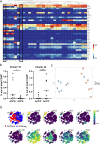Immunoprofiling of early, untreated rheumatoid arthritis using mass cytometry reveals an activated basophil subset inversely linked to ACPA status
- PMID: 34715910
- PMCID: PMC8555233
- DOI: 10.1186/s13075-021-02630-8
Immunoprofiling of early, untreated rheumatoid arthritis using mass cytometry reveals an activated basophil subset inversely linked to ACPA status
Abstract
Background: Autoantibody production is a hallmark of rheumatoid arthritis (RA). Anti-citrullinated protein antibodies (ACPA) are highly disease-specific, and their presence is associated with more severe disease and poor prognosis compared to ACPA-negative patients. However, the immune cell composition associated with antibody-positive/negative disease is incompletely defined. Mass cytometry (MC) is a high-dimensional technique offering new possibilities in the determination of the immune cell composition in rheumatic diseases. Here, we set up a broad phenotyping panel to study the immune cell profile of early untreated RA to investigate if specific immune cell subsets are associated with ACPA+ versus ACPA- RA.
Methods: Freshly obtained PBMCs of early, untreated RA patients (8 ACPA+ and 7 ACPA-) were analysed using a 36-marker MC panel, including markers related to various immune lineages. Data were processed using Cytosplore for dimensional reduction (HSNE) and clustering. Groups were compared using Cytofast. A second validation cohort of cryopreserved PBMCs obtained from early RA patients (27 ACPA+ and 20 ACPA-) was used to confirm MC data by flow cytometry (FC). FC data were processed and analysed using both an unsupervised analysis pipeline and through manual gating.
Results: MC indicated no differences when comparing major immune lineages (i.e. monocytes, T and B cells), but highlighted two innate subsets: CD62L+ basophils (p = 0.33) and a subset of CD16- NK cells (p = 0.063). Although the NK cell subset did not replicate by FC, FC replication confirmed the difference in CD62L+ basophil frequency when comparing ACPA+ to ACPA- patients (mean 0.32% vs. 0.13%; p = 0.01).
Conclusions: Although no differences in major lineages were found between early ACPA+ and ACPA- RA, this study identified the reduced presence of activated basophils in ACPA-negative disease as compared to ACPA-positive disease and thereby provides the first evidence for a connection between activated basophils and ACPA status.
Keywords: Basophils; CD62L; Immune-profiling; Mass cytometry; Rheumatoid arthritis.
© 2021. The Author(s).
Conflict of interest statement
HK has performed this work as part of her PhD studies and is currently an employee of Fluidigm. GB is currently an employee of VisuaLyte.
Figures



Similar articles
-
Is Anti-Citrullinated Protein Antibody-Positive Rheumatoid Arthritis Still a More Severe Disease Than Anti-Citrullinated Protein Antibody-Negative Rheumatoid Arthritis? A Longitudinal Cohort Study in Rheumatoid Arthritis Patients Diagnosed From 2000 Onward.Arthritis Care Res (Hoboken). 2018 Jul;70(7):987-996. doi: 10.1002/acr.23497. Epub 2018 May 28. Arthritis Care Res (Hoboken). 2018. PMID: 29266813 Free PMC article.
-
Anti-citrullinated protein antibodies in rheumatoid arthritis: a functional role for mast cells and basophils?Ann Rheum Dis. 2011 Mar;70 Suppl 1:i55-8. doi: 10.1136/ard.2010.138032. Ann Rheum Dis. 2011. Retraction in: Ann Rheum Dis. 2014 May;73(5):948. doi: 10.1136/ard.2010.138032ret. PMID: 21339220 Retracted. Review.
-
Evidence for a functional role of IgE anticitrullinated protein antibodies in rheumatoid arthritis.Proc Natl Acad Sci U S A. 2010 Feb 9;107(6):2586-91. doi: 10.1073/pnas.0913054107. Epub 2010 Jan 25. Proc Natl Acad Sci U S A. 2010. Retraction in: Proc Natl Acad Sci U S A. 2013 Dec 10;110(50):20345. doi: 10.1073/pnas.1320459110. PMID: 20133791 Free PMC article. Retracted.
-
Only rheumatoid factor-positive subset of anti-citrullinated peptide/protein antibody-negative rheumatoid arthritis may seroconvert to anti-citrullinated peptide/protein antibody-positive.Int J Rheum Dis. 2017 Jun;20(6):731-736. doi: 10.1111/1756-185X.13000. Epub 2017 Feb 15. Int J Rheum Dis. 2017. PMID: 28198158
-
Detection of anti-citrullinated protein antibody (ACPA) in saliva for rheumatoid arthritis using DBA mice infected with Porphyromonas gingivalis.Arch Oral Biol. 2019 Dec;108:104510. doi: 10.1016/j.archoralbio.2019.104510. Epub 2019 Aug 11. Arch Oral Biol. 2019. PMID: 31446118 Review.
Cited by
-
Immune Cell Plasticity in Inflammation: Insights into Description and Regulation of Immune Cell Phenotypes.Cells. 2022 Jun 2;11(11):1824. doi: 10.3390/cells11111824. Cells. 2022. PMID: 35681519 Free PMC article. Review.
-
Spondyloarthritis mass cytometry immuno-monitoring: a proof of concept study in the tight-control and treat-to target TiCoSpA trial.Clin Rheumatol. 2023 Sep;42(9):2387-2396. doi: 10.1007/s10067-023-06637-1. Epub 2023 Jun 12. Clin Rheumatol. 2023. PMID: 37306812 Free PMC article.
-
A small-scale preliminary study utilizing mass cytometry to distinguish two forms of arthritis.Clin Rheumatol. 2025 Jan;44(1):495-502. doi: 10.1007/s10067-024-07233-7. Epub 2024 Nov 26. Clin Rheumatol. 2025. PMID: 39589424
-
Basophil-derived exosomes exacerbate systemic lupus erythematosus by regulating B-cell proliferation via miR-24550.BMC Med. 2025 Aug 22;23(1):490. doi: 10.1186/s12916-025-04324-3. BMC Med. 2025. PMID: 40846943 Free PMC article.
-
Comparative single-cell multiplex immunophenotyping of therapy-naive patients with rheumatoid arthritis, systemic sclerosis, and systemic lupus erythematosus shed light on disease-specific composition of the peripheral immune system.Front Immunol. 2024 Apr 25;15:1376933. doi: 10.3389/fimmu.2024.1376933. eCollection 2024. Front Immunol. 2024. PMID: 38726007 Free PMC article.
References
-
- Fonseka CY, et al. Mixed-effects association of single cells identifies an expanded effector CD4+ T cell subset in rheumatoid arthritis. Sci. Transl. Med. 2018;10. https://pubmed.ncbi.nlm.nih.gov/30333237/. - PMC - PubMed
-
- Matthijssen XME, Niemantsverdriet E, Huizinga TWJ, van der Helm-van Mil AHM. Enhanced treatment strategies and distinct disease outcomes among autoantibody-positive and -negative rheumatoid arthritis patients over 25 years: a longitudinal cohort study in the Netherlands. PLoS Med. 2020;17:e1003296. doi: 10.1371/journal.pmed.1003296. - DOI - PMC - PubMed
Publication types
MeSH terms
Substances
Grants and funding
LinkOut - more resources
Full Text Sources
Medical

